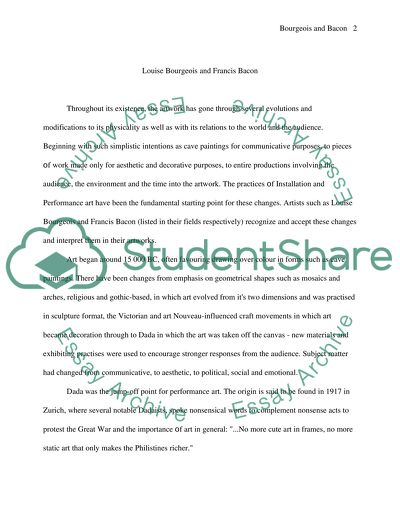Cite this document
(Suffering Body in the Artwork of L. Bourgeois and F. Bacon Essay Example | Topics and Well Written Essays - 1500 words, n.d.)
Suffering Body in the Artwork of L. Bourgeois and F. Bacon Essay Example | Topics and Well Written Essays - 1500 words. https://studentshare.org/visual-arts-film-studies/1514493-themes-the-suffering-body-by-compare-the-work-2-artist-louise-bourgeois-and-francis-bacon-in-different-and-similar-approach-under-the-theme-of-suffering-bo
Suffering Body in the Artwork of L. Bourgeois and F. Bacon Essay Example | Topics and Well Written Essays - 1500 words. https://studentshare.org/visual-arts-film-studies/1514493-themes-the-suffering-body-by-compare-the-work-2-artist-louise-bourgeois-and-francis-bacon-in-different-and-similar-approach-under-the-theme-of-suffering-bo
(Suffering Body in the Artwork of L. Bourgeois and F. Bacon Essay Example | Topics and Well Written Essays - 1500 Words)
Suffering Body in the Artwork of L. Bourgeois and F. Bacon Essay Example | Topics and Well Written Essays - 1500 Words. https://studentshare.org/visual-arts-film-studies/1514493-themes-the-suffering-body-by-compare-the-work-2-artist-louise-bourgeois-and-francis-bacon-in-different-and-similar-approach-under-the-theme-of-suffering-bo.
Suffering Body in the Artwork of L. Bourgeois and F. Bacon Essay Example | Topics and Well Written Essays - 1500 Words. https://studentshare.org/visual-arts-film-studies/1514493-themes-the-suffering-body-by-compare-the-work-2-artist-louise-bourgeois-and-francis-bacon-in-different-and-similar-approach-under-the-theme-of-suffering-bo.
“Suffering Body in the Artwork of L. Bourgeois and F. Bacon Essay Example | Topics and Well Written Essays - 1500 Words”. https://studentshare.org/visual-arts-film-studies/1514493-themes-the-suffering-body-by-compare-the-work-2-artist-louise-bourgeois-and-francis-bacon-in-different-and-similar-approach-under-the-theme-of-suffering-bo.


